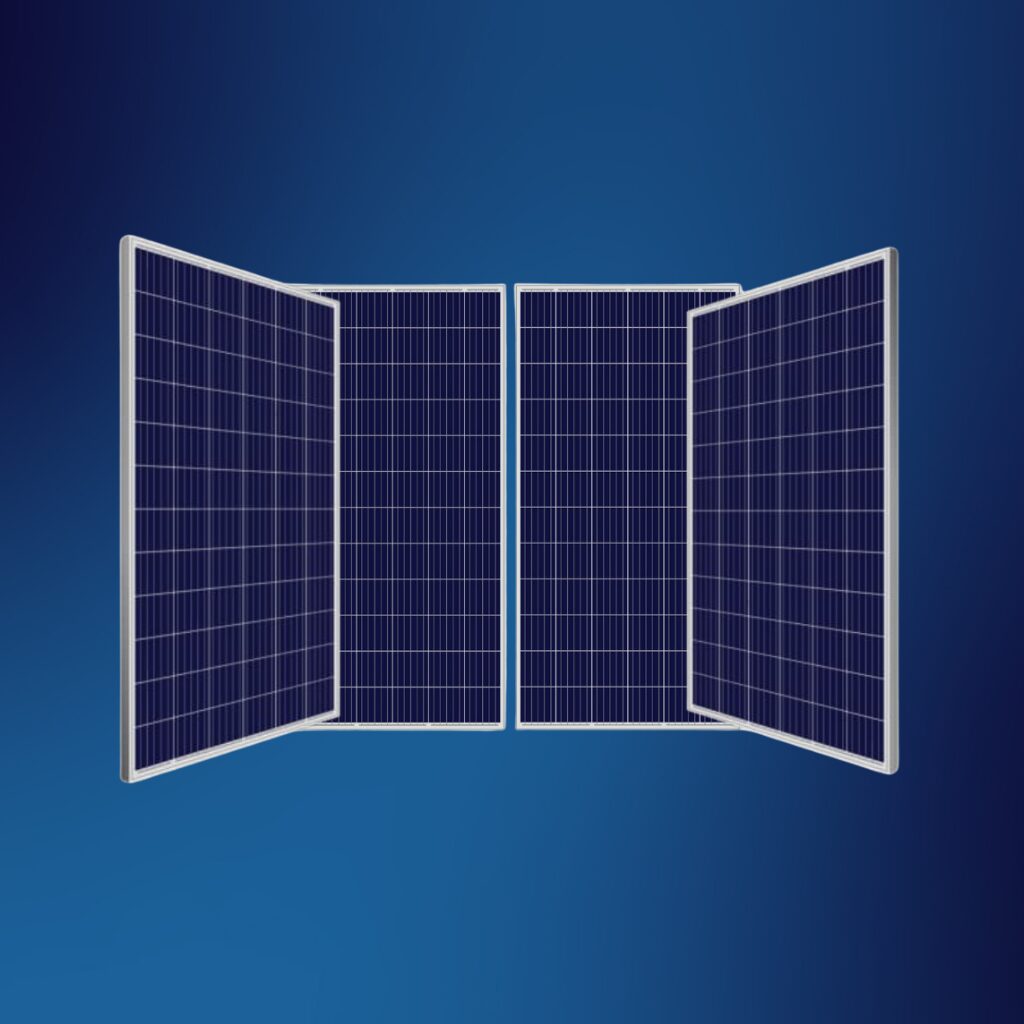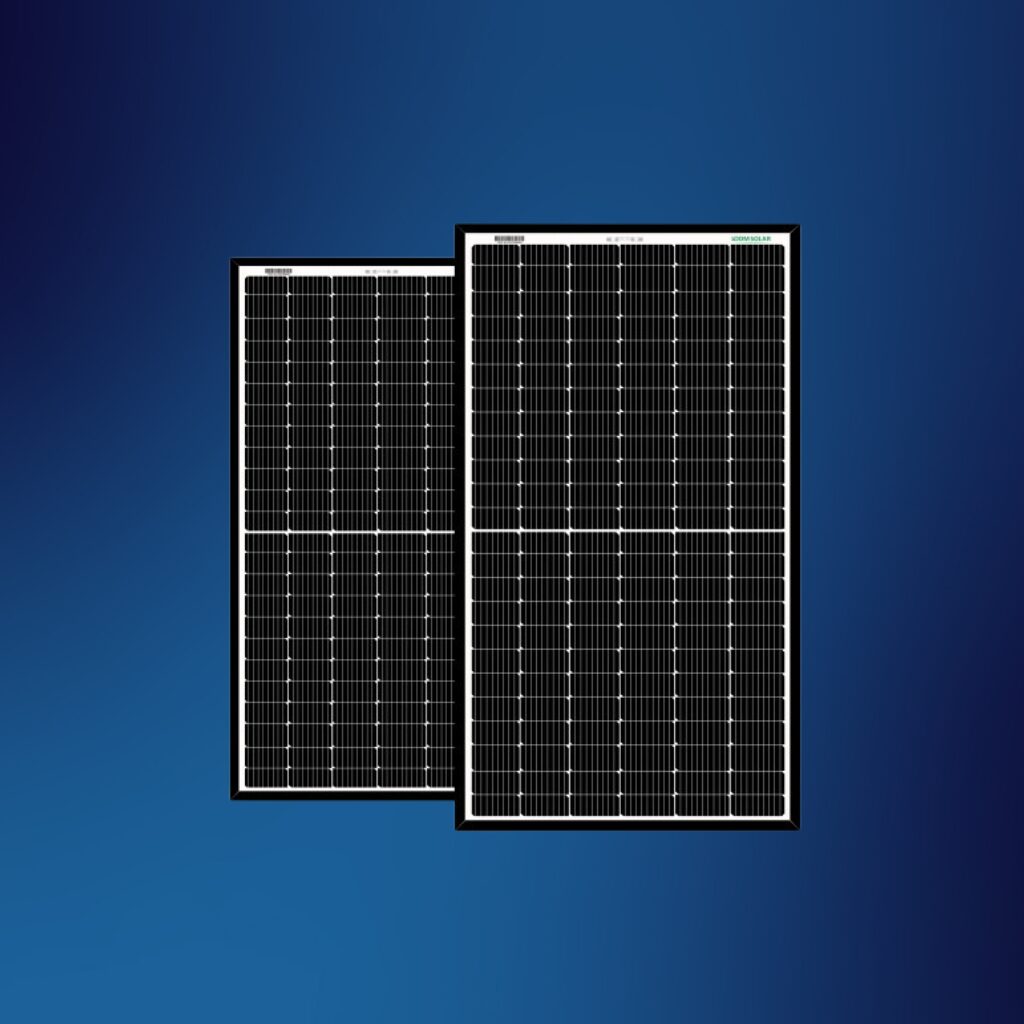


You can choose from different types of solar panels to set up a solar plant. Mono-PERC half-cut, mono-PERC half-cut bifacial, and TOPCon bifacial are the most-bought panels currently. HJT panels will be the most efficient and durable solar panels in the future.
Here are the different kinds of solar panels you can install at your home:
Efficiency: 13- 17%
Average Capacity: 335 W
Average Dimension: 1956 mm x 992 mm x 36 mm
Polycrystalline panels are made with polycrystalline solar cells. These cells are made from multiple crystals of silicon. The manufacturing process is less expensive and easier than for monocrystalline panels.
Polycrystalline panels are however outdated and have been replaced with monocrystalline panels, an advancement in solar panel technology.

Average Weight | 20.5 kg |
Temperature coefficiency | -0.38%/°C |
Product warranty | 10 years |
Performance warranty | 27 years |
1st year degradation | 2.5% |
Annual power degradation | 0.67% from 2nd to 27th year |
Colour | Blue |
Efficiency in monofacial mode: 20-22%
Efficiency in bifacial mode: 24-28%
Average Capacity: 550 W
Average Dimension: 2272 mm x 1133 mm x 35 mm
When a single silicon crystal is used to manufacture a solar cell, it is called a monocrystalline cell.
PERC stands for Passivated Emitter and Rear Contact. This layer reflects the sunlight which passes through the cells, giving the solar cells another chance to convert the sunlight into electricity. Mono-PERC solar panels have monocrystalline cells combined with PERC technology.
These panels come with both full-cut and half-cut cells. Half-cut technology guarantees power production even if a shadow partly covers the panel.

Average Weight (Monofacial) | 27 to 28 kg |
Average Weight (Transparent Backsheet) | 28 to 30 kg |
Average Weight (Glass-to-Glass) | 32.5 kg to 37 kg |
Temperature coefficiency | -0.37%/°C |
Product warranty | 12 years |
Performance warranty | 25 years |
1st year degradation | <2.0% |
Annual power degradation | <0.55% from 2nd to 25th year |
Colour | Black |
Das Energie Private Limited has onboarded solar installation vendors throughout India. We have made the cost of installing a solar system transparent by freely displaying the quotations offered by different local vendors. You can get the best value for money by getting quotations from us.
Efficiency in monofacial mode: 22-23%
Efficiency in bifacial mode: 27-30%
Average Capacity: 570 W
Average Dimension: 2278 mm x 1133 mm x 30 mm
TOPCon is a new technology. TOPCon panels incorporate a thin tunnel oxide layer. This layer minimises electron recombination losses, boosting overall efficiency.
The most common type of TOPCon panels are the N-type ones; however, P-type TOPCon panels are also available. Phosphorous doping makes a TOPCon panel N-type whereas boron is used for creating a P-type TOPCon panel. TOPCon panels mostly come with half-cut cells.
Average Weight (Transparent Backsheet) | 28 kg |
Average Weight (Glass-to-Glass) | 32 kg to 40 kg |
Temperature coefficiency | -0.31%/°C |
Product warranty | 12 years |
Performance warranty | 30 years |
1st year degradation | <1% |
Annual power degradation | <0.40% from 2nd to 30th year |
Colour | Black |

Efficiency in monofacial mode: 23-24%
Efficiency in bifacial mode: 27-30%
Average Capacity: 670
Average Dimension: 2383 mm × 1303 mm × 35 mm
HJT panels combine crystalline silicon with thin-film silicon layers. This technology makes HJT more efficient than PERC. HJT panels use half cut cells.
Currently, HJT panels are unavailable in the Indian market, but they can become the best type of solar panels in the future.

Average Weight (Transparent Backsheet) | 38.5 kg |
Temperature coefficiency | -0.243%/°C |
Product warranty | 30 years |
Performance warranty | 30 years |
1st year degradation | Around 1% |
Annual power degradation | 0.35% after 1st year |
Colour | Black, Blue |
The power generated by a solar panel is in the form of Direct Current (DC). But it has to be converted into Alternating Current (AC) before it can power your house. You have to buy a solar inverter for home for your solar system for DC-to-AC conversion. You can learn about the best solar inverters in India by visiting our blog.
Das Energie Private Limited has onboarded solar installation vendors throughout India. We have made the cost of installing a solar system transparent by freely displaying the quotations offered by different local vendors. You can get the best value for money by getting quotations from us.
Depending on whether solar panels come with transparent or opaque back sheet, they can be divided into 2 categories:
These solar panels come with an opaque white polymer made of a plastic back sheet and absorb sunlight only from the front side. Both polycrystalline and mono-PERC half cut panels are available in monofacial mode.
The back sheet in bifacial solar panels is transparent and made of heat-strengthened tempered glass or transparent polymer-made plastic sheet. Bifacial solar panels absorb sunlight from the front as well as the rear. It enhances the efficiency and power output of the panels by 5-25%. Mono-PERC half cut, TOPCon, and HJT panels are available in bifacial mode.
Since we are discussing solar panels, you must know that in most Indian households, a 3 kW solar system can generate enough electricity to meet all power requirements. You can read our blog to learn about its installation cost.
There are certain solar panels which are designed for outdoor activities and integration in buildings:
Flexible solar panels are made of usually:
These panels are highly portable and can be used outdoors as you can carry them easily. The catch of this type of solar panel is that these have a low efficiency compared to conventional solar panels
Features:
BIPV stands for building-integrated photovoltaic. These panels can be integrated into walls, roofs and windows of buildings. It can enhance the architectural appeal of a building and eliminate the need for a mounting structure. You can read our blog to learn about different kinds of mounting structures.
Features:

You must evaluate different types of solar panels based on their efficiency, functionality, power output, and the area they occupy. Analysing your electricity requirement will help you estimate the capacity of your solar system. You may even get a subsidy on using DCR-certified and ALMM-listed solar panels. For the subsidy, your DISCOM must be enlisted with the MNRE as well.
Only a professionally skilled vendor must install your solar system. You can find the quotations offered by DISCOM-empanelled vendors at Das Energie Private Limited. We have onboarded vendors after thoroughly vetting them.
The types of solar panels you can buy include polycrystalline, mono-PERC half cut, mono-PERC half cut bifacial, and TOPCon. Among these, TOPCon panels offer the highest efficiency of 22-23%.
Some factors which you must consider are your electricity requirements, the efficiency of the solar panels, area the solar system will occupy, components of the solar system, shadow-free area on the roof, and the angle at which the sunlight will fall on the solar panels.
DCR stands for Domestic Content Requirement. It is a criterion established by the government for providing solar installation subsidies. For a panel to be DCR-certified, all its cells and other components must be made in India.
The electricity output, technology, efficiency, temperature coefficient, degradation rate, and whether the panels are DCR or non-DCR are some of the things to check in a solar panel.
Currently, TOPCon panels provide the highest output. Their output can be in the range of 570 W to 620 W.
Mr Das’ expertise spans various aspects of solar energy, including photovoltaic technology, solar thermal systems, and energy storage solutions. He contributes profusely to our blogs to share his keen knowledge and expertise with those seeking information regarding solar system installation. He brings a wealth of practical knowledge and real-world experience to his writing. His articles offer valuable guidance on navigating the intricacies of solar energy projects, from site assessment and system sizing to financing options and maintenance strategies.

2 Comments
Anurag Thakur
The section on flexible solar panels was very enlightening. However, I’m curious about their longevity and overall cost compared to traditional panels. Could you elaborate on that in future posts?
Aditi Singh
Thank you for breaking down the different types of solar panels and their respective technologies. It makes the decision-making process much easier for someone who is new to solar energy.